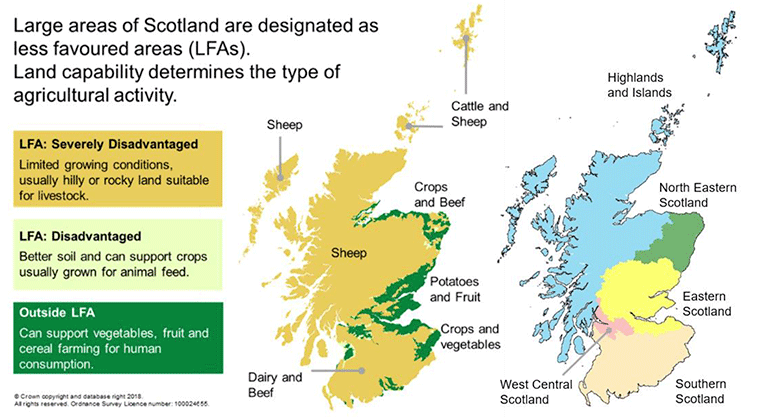Farm Business Survey 2018-2019: profitability of Scottish farming
An analysis of Scottish Farm Business Survey 2018 to 2019 data, focussing on profit from farming in the supported sectors of agriculture, profit from alternative sources, support payments, and long term profitability of Scottish farm businesses.
This document is part of a collection
1. Introduction
This Official Statistics report provides additional analysis of Scottish Farm Business Income data. It provides detailed analysis of the profit from farming, profit from alternative sources, support through the Common Agricultural Policy (CAP) and other payments, and long term profitability of Scottish farm businesses. It accompanies the National Statistics publication of Scottish Farm Business Income: Annual Estimates 2018-19 and is based on the latest published statistics for the financial period 2018-19, the 2018 crop year.
Total Income from Farming (TIFF) is the official measure of the profit (income minus costs) produced by all agriculture in Scotland. The Scottish Farm Business Survey (FBS) allows an in-depth look at the profitability of Scottish farming based on the detailed financial data collected from a sample of farms in receipt of CAP payments and support Scotland.
1.1 Agriculture in Scotland
Agriculture is an important and very visible part of the rural economy with total output worth £3.18 billion[3] and taking place on over 80% of the land mass in Scotland[4]. Agricultural output across Scotland is highly dependent on the land capability. Large areas of Scotland have limited arable growing conditions. These are usually hilly or rocky lands that are more suitable for livestock.
Areas with limited growing conditions are designated as Less Favourable Area (LFA) in recognition of:
- the presence of land of poor productivity, which is difficult to cultivate and with a limited potential which cannot be increased except at excessive cost, and which is mainly suitable for extensive livestock farming;
- lower than average production, compared to the main indices of economic performance in agriculture;
- a low or dwindling population predominantly dependent on agricultural activity, the accelerated decline of which could cause rural depopulation.
In 2018, 86% of the total agricultural land area in Scotland was designated as LFA[4]. Scotland is divided into five regions, though they have very different sizes in terms of agricultural area and LFA land. These regions, land types and the predominant types of farming undertaken across Scotland are shown in Figure 1.
The North Eastern, Eastern and Southern areas of Scotland benefit from larger areas of non-LFA land, and as a consequence typically create the most profit from agricultural activity[5].
In contrast, while the Highlands and Islands area is large, most of this land consists of LFA and agricultural profit per hectare is lower[5].
West Central Scotland mainly comprises the urban area around Glasgow, and is not a significant agricultural area represented in these statistics[5].

In Scotland, agriculture contributes around 0.8% of the total Gross Value Added (GVA) economic output[6]. However, it makes up a larger proportion of the rural economic output. It also employs around 2.5% of the working population[6], although this varies across the country. The largest user of agricultural output domestically is the food and drink industry alongside many other suppliers[7].
Agricultural productivity is a measure of the growth in output relative to input. Scotland's productivity base levels were lower than the rest of the UK, reflecting the higher proportion of land designated as Less Favourable Areas. However, Scottish agriculture has higher productivity growth than the rest of the UK and around the same as other OECD countries. Much of the increased productivity gains are attributed to improved research and development, training and education, and improved technology and infrastructure[8].
In addition to fluctuations in market prices which impact productivity and profitability, climate and geography provide additional challenges and variances in weather conditions and outbreaks of crop and livestock diseases can have large impacts on farm profitability.
The large area of LFA land in Scotland limits the expansion potential of more profitable farm types. While the uplands are ideal for low intensity grazing including sheep and some cattle, these tend to be less profitable types of farming[9] and have the least capacity to improve or change to more profitable production systems.
As a consequence, agricultural output in Scotland is still heavily dependent on beef, sheep and dairy, accounting for around 50% of the total value of agricultural output[10].
Currently, the majority of support offered to farms in Scotland is provided under the EU Common Agricultural Policy (CAP).
The annual total of CAP payments is around £650 million, of which 51% supports active farming to provide a safety net for farmers and crofters by supplementing their main business income. Around 21% is provided through 'Greening' which is a policy aimed at agricultural practices beneficial for the climate and environment which is paid on top of the basic payment scheme.
The additional 28% is spent on Pillar 2 funding, which is provided to support agriculture in less favoured areas, other environmental programmes, forestry, and supply chain work[11].
1.2 Wider impacts of Scottish agriculture
The contribution made by agriculture to Scottish society and the environment is broader than the measures captured in traditional economic indicators.
Agriculture plays an important role in rural communities, and, with tourism and hospitality, contributes to the 'Scottish' brand, for example through Scotch Beef or Scotch Lamb Protected Geographic Indication (PGI) from the QMS Cattle & Sheep Assurance Scheme[12].
Most of Scotland's land area is used for agriculture. Agriculture impacts the environment, climate change and biodiversity in both positive and negative ways. Some farm practices can contribute positively to natural flood management, carbon capture, soil management and biodiversity. However, some farm practices also have negative impacts on soil and water quality, biodiversity, erosion, and greenhouse gas emissions.
Through these wider impacts, the sector also has an impact on the many other businesses in Scotland, such as leisure and tourism, food and drink and forestry which are reliant on good environmental practices.
Contact
Email: Harriet.Houlsby@gov.scot
There is a problem
Thanks for your feedback